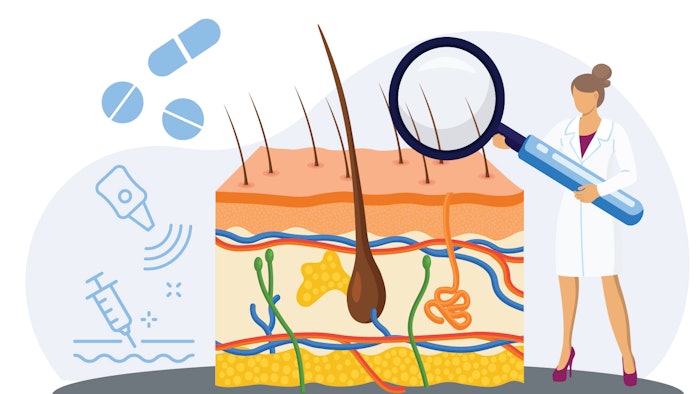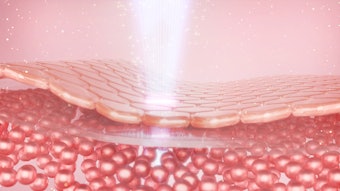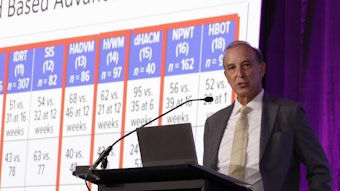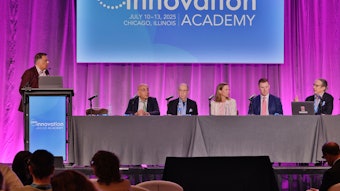Head for the cure
Hair loss and scalp disorder session spotlights patients’ medical and emotional needs.

Hair loss is complex and rooted in a variety of causes that contribute to the physical and psychosocial effects that mark the condition, said Michelle B. Tarbox, MD, FAAD, associate professor of dermatology at Texas Tech University Health Sciences Center in Lubbock. Dr. Tarbox was among the speakers at the July 12 session, P011 – Managing Hair Disorders, which underscored the importance of formulating individually appropriate treatment plans for affected patients.
The good news is that both old and new therapies have a place in treating hair loss (scarring and non-scarring alopecias) and scalp disorders, Dr. Tarbox said.
“Understanding the underlying etiology of alopecia and scalp disorders — whether inflammatory, autoimmune, infectious, hormonal, or mechanical — is critical to arrive at the correct diagnosis and prescribe effective management,” she said. “When treating patients [for this condition], the most important advice I can offer colleagues is to truly listen to the patient’s story and examine the scalp closely — both clinically and dermoscopically.”
There’s a reason for this
Dr. Tarbox provided a primer on hair loss and scalp disorders, reminding attendees that these are common and often share overlapping presentations and pathophysiology. Non-scarring alopecias include androgenetic alopecia, telogen effluvium, and alopecia areata. Inflammation plays varying roles in these types, ranging from a direct primary role in alopecia areata to a secondary role in androgenetic alopecia, she said.

Inflammation takes center stage with scarring or cicatricial alopecias including lichen planopilaris (LPP), central centrifugal cicatricial alopecia (CCCA), and discoid lupus erythematosus (DLE), Dr. Tarbox said. In these diseases, inflammatory cells permanently damage follicular structures. Typically, she said, CCCA features slow, smoldering inflammation that leads to fibrosis of the upper follicle, LPP exhibits an aggressive lichenoid attack on the follicular infundibulum that damages the follicular stem cells, and DLE causes widespread follicular and epidermal destruction through immune complex-mediated interface inflammation.
“Alopecia can also be brought on by direct physical stressors too, as is the case with traction alopecia or chemical damage to the scalp or hair shaft through straightening, perming, or finishing products,” Dr. Tarbox said.
What are we looking at?
 Carolyn Goh, MD, FAAD
Carolyn Goh, MD, FAAD
It’s a good reminder, Dr. Goh told attendees, to understand what you are treating as well as the patient’s goals.
“Breaking it down into components of scalp-directed and hair-directed treatments can be helpful. Performing a biopsy — or more than one — or repeating a biopsy may be helpful to guide the best next steps,” she said.
Hair loss can be challenging in the clinic as it is “an emotionally charged subject” for a lot of patients, Dr. Goh said. When listening to patients’ goals, consider what treatments they may be willing to try or not try.
Pathways ahead
 Paradi Mirmirani, MD, FAAD
Paradi Mirmirani, MD, FAAD
JAK inhibition has led to successful treatment outcomes. In 2022, the first FDA treatment for alopecia areata (AA) was approved for patients with severe scalp hair loss, and since then, two more FDA treatments have been approved, Dr. Mirmirani said.
JAK inhibitors offer promise for patients with severe hair loss due to AA, but it is important to include shared decision-making when discussing treatment options, Dr. Mirmirani said. In patients who are not good candidates for treatment with a JAK inhibitor, or in patients who are non-responders, other treatments can be considered or “stacked” with a JAK inhibitor, she said.
“It’s important to note that patients with severe AA have significantly more treatment options in 2025!” Dr. Mirmirani said.
Most of the time
According to presenter Kathie Huang, MD, FAAD, assistant professor of dermatology at Harvard Medical School in Boston, there are other, more common types of hair loss, including female pattern thinning and male pattern balding. In these cases, she said, the hairs become miniaturized and finite over time, leading to overall thinning and balding.
Telogen effluvium is another common cause of hair loss dermatologists often treat. Telogen effluvium occurs when the hair starts to shed in reaction to medication, illness, stress, or other medical issues. Dr. Huang said it tends to be reversible if the underlying cause is addressed and resolved.
Although there are many medications available to treat hair loss, they might not be suitable for certain patients due to other comorbidities, or patients may prefer to avoid medications, Dr. Huang said. Many patients with alopecia are also interested in nutritional supplements for thickening their hair. Unfortunately, the data to support many of the nutritional supplements are limited, she said.
“Patients are inundated with information from social media, and it is challenging to navigate all the information and advertising directed at patients,” Dr. Huang said. “Therefore, it is important for clinicians to be knowledgeable of the nutritional supplements available for hair loss so we can help guide patients to understand their risks and benefits.”
Must-have conversations
Session presenter Chesahna Kindred, MD, MBA, FAAD, the founding dermatologist behind Kindred Hair & Skin Center in Marriottsville, Maryland, underscored the emotional nature of hair loss and said she encourages patients to find hair professionals who promote healthy hair styles. Some hair techniques, such as chemicals, straighteners, and weaves, can prompt a form of alopecia known as traction alopecia, which results from consistent pulling or tension on the hair.

“Many colleagues face time constraints when seeing patients with hair loss due to the emotional impact of the condition,” Dr. Kindred said. “To efficiently gather patient history while still allowing them to share their story, I advise using a comprehensive questionnaire. This allows patients to express their concerns in detail beforehand, enabling the dermatologist to focus on higher-yield areas during the appointment. “
After reviewing the questionnaire, Dr. Kindred said dermatologists can ask if there’s anything else the patient would like to share that wasn’t covered. For example, she said, if the questionnaire asks about inflammatory symptoms and the patient answers no, the discussion can then center on other relevant aspects of their history.
Visual evidence
Amy J. McMichael, MD, FAAD, professor of dermatology at Wake Forest School of Medicine in Winston-Salem, North Carolina, also presented at the session and echoed Dr. Kindred’s sentiment. Dr. McMichael said she has witnessed patients’ emotions interfering with gathering an accurate history. For example, quantifying hair loss is of the utmost importance, she told attendees, and might be difficult to recount.
“When patients come to the dermatologist for evaluation for alopecia, they are distraught and very tuned into the difference between what their hair was prior to the loss and what is happening currently,” Dr. McMichael said. “For this reason, they often do not have a realistic perception of the severity of their loss. Documenting the hair loss with photos across the timeline of treatment can help patients note that the loss is either stable or improving.”
Dr. McMichael encouraged dermatologists to use trichoscopic photos to determine when a treatment may or may not be effective and to look for clues about hair care behavior that may contribute to hair loss, such as in traction alopecia. Doing so provides visual signs of active inflammation with individual hair follicles.
The session also featured speakers Victoria Holloway Barbosa, MD, FAAD; Cathryn Joy Sibbald, MD, FAAD; and Meena Kumari Singh, MD, FAAD.
Pearls to remember
 Michelle B. Tarbox, MD, FAAD
Michelle B. Tarbox, MD, FAAD
“Hair loss is never just cosmetic. It is deeply personal, often signaling an underlying pathology and always deserving of a thoughtful, compassionate, and individualized approach,” said Dr. Tarbox. “Diagnosis is detective work. Treatment is teamwork. Healing is holistic.”
Below are Dr. Tarbox’s recommendations for formulating an individualized treatment plan for hair loss and scalp disorders.
When formulating a treatment plan, dermatologists should:
- Classify the alopecia (scarring versus non-scarring): This fundamentally changes your management.
- Set realistic expectations: Hair regrowth is slow, and stabilizing loss is often a win.
- Be proactive about inflammation: If you see perifollicular scale, erythema, or pustules, treat inflammation early and aggressively.
- Address contributing factors: Hormonal imbalances, nutritional deficiencies, stressors — all should be evaluated and optimized.
- Tailor therapy: Think about the patient’s lifestyle, comorbidities, and preferences when recommending treatment. There is no “one-size-fits-all” approach.
- Lead with empathy: Hair loss affects an individual’s identity and confidence, and acknowledging the emotional impact can strengthen the therapeutic relationship.
Tried-and-true treatment options are foundational, including:
- Topical minoxidil remains a workhorse for both androgenetic alopecia and telogen effluvium support. It is also a non-hormonal option for patients in whom hormonal therapies may be contraindicated, such as those recovering from breast cancer.
- Intralesional corticosteroids are still the gold standard for alopecia areata and other inflammatory scalp conditions.
- Antifungal therapies (like oral terbinafine) are critical for infectious scalp diseases like tinea capitis.
- Immunosuppressants, such as hydroxychloroquine and mycophenolate, continue to be valuable for scarring alopecias.
Exciting new therapies reshaping the landscape:
- JAK inhibitors (oral and topical) are showing tremendous promise for alopecia areata and other autoimmune-related hair loss.
- Low-level laser therapy is gaining support as a noninvasive adjunct for androgenetic alopecia.
- Platelet-rich plasma (PRP) injections offer a regenerative approach, particularly for androgenetic alopecia and some cases of alopecia areata.
- Biologics targeting type 2 inflammation may eventually become tools for certain scarring alopecias.
- Low-dose oral minoxidil has been a game changer for treating alopecia and can help improve hair regrowth across multiple alopecia types. This powerful systemic medication must be used thoughtfully, with properly selected patients and appropriate counseling.











